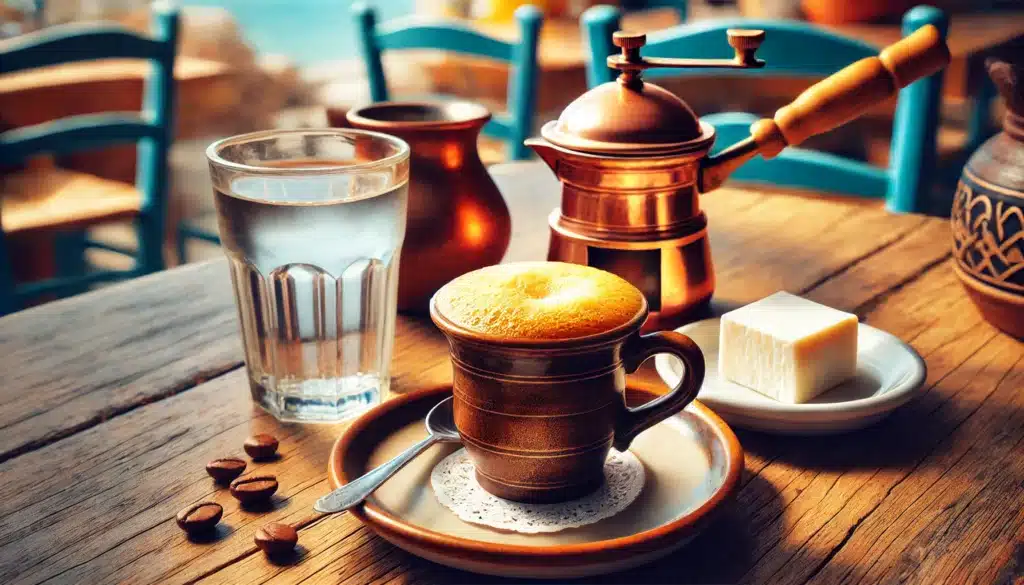Greek coffee isn’t just a beverage—it’s a ritual, a conversation starter, and a symbol of community. Brewed in a small pot called a briki and served in tiny cups, Greek coffee is strong, thick, and topped with a layer of golden foam called kaimaki.
It’s enjoyed slowly, often accompanied by good company, traditional sweets, and plenty of talk.
In this article, you’ll learn:
✅ What makes Greek coffee different from Turkish or Arabic coffee
✅ Step-by-step brewing instructions for a perfect cup
✅ How to achieve a rich foam (kaimaki)
✅ Cultural tips and how to enjoy it like a local
Let’s stir up something special! 🇬🇷☕
What Makes Greek Coffee Unique?
✔ Ultra-fine grind – Like flour, even finer than espresso
✔ Brewed slowly over low heat – In a briki (copper pot)
✔ No filtering – Grounds settle at the bottom of the cup
✔ Strong flavor – Small, potent servings (60–80ml per cup)
✔ Foamy top (kaimaki) – The prized golden crema
💡 Greek coffee is similar to Turkish coffee, but it has its own ritual and regional pride, especially in mainland Greece and on the islands.
What You’ll Need
✅ Briki (μπρίκι) – Small coffee pot with a long handle
✅ Ultra-finely ground Greek coffee – Ground specifically for briki-style brewing
✅ Filtered water – Cold and clean
✅ Sugar (optional) – Added before brewing
✅ A small demitasse cup
💡 Recommended Greek Coffee Brands:
- Loumidis Papagalos – The most iconic
- Bravo Greek Coffee – Smooth and mild
- Venizelos – Strong and rich
Greek Coffee Sweetness Levels
In Greece, sweetness is added before brewing, not after. Here are the standard terms:
🥄 Sketos (σκέτος): No sugar – strong and bitter
🥄 Metrios (μέτριος): 1 teaspoon sugar – balanced
🥄 Glykos (γλυκός): 2 teaspoons sugar – sweet
🥄 Variglykos (βαρύγλυκος): Very sweet and very strong
💡 Tip: Know your guest’s preference—offering the wrong sweetness is a cultural faux pas!
Step-by-Step: How to Brew Authentic Greek Coffee
☕ Step 1: Measure Your Water
Use your demitasse cup to measure cold water and pour it into the briki.
One cup of water = one serving.
☕ Step 2: Add Coffee and Sugar
Add 1 heaping teaspoon of Greek coffee per serving.
Add sugar now according to your preferred sweetness.
Do not stir yet.
☕ Step 3: Stir Gently Until Dissolved
Stir until the coffee and sugar are fully dissolved.
After that, don’t stir again!
💡 Why no second stir? Stirring again disturbs the formation of kaimaki (foam).
☕ Step 4: Heat Slowly Over Low Heat
Place the briki on low heat.
Watch carefully as tiny bubbles start to form.
As the coffee rises and the foam builds, remove it just before it boils over.
💡 Important: Don’t let it boil or the foam will collapse. The goal is a thick, unbroken foam.
☕ Step 5: Serve With Style
Pour slowly into the cup to preserve the foam.
Do not stir the coffee once served.
Allow the grounds to settle for 1–2 minutes before sipping.
✅ Serve with:
- A glass of cold water
- A traditional Greek sweet like loukoumi (Greek delight) or a small cookie
Greek Coffee Etiquette
Greek coffee is best enjoyed slowly and socially. In villages and city cafés alike, locals sit for hours over a single cup, talking, reading, or playing tavli (backgammon).
💬 Some cultural tips:
✔ Don’t rush—Greek coffee is about conversation, not caffeine
✔ It’s normal to leave a bit of muddy grounds in the bottom
✔ Never serve Greek coffee without offering cold water
Greek Coffee vs. Turkish Coffee: What’s the Difference?
While nearly identical in preparation, Greek coffee is more than a method—it’s an identity. After political tensions in the 20th century, Greece embraced the coffee as uniquely theirs.
| Feature | Greek Coffee | Turkish Coffee |
|---|---|---|
| Foam name | Kaimaki | Köpük |
| Serving | Often with loukoumi | Often with Turkish delight |
| Cultural setting | Kafeneio (Greek cafés) | Kahvehane (Turkish coffeehouse) |
| Flavor | Milder, more floral | Stronger, bolder |
Common Mistakes & How to Avoid Them
❌ No foam (kaimaki) → Heat was too high → Use lower heat
❌ Boiled over → Didn’t remove in time → Watch closely
❌ Coffee is bitter → Too strong for your taste → Try metrios or glykos
❌ Grounds in every sip → Didn’t let it settle → Wait 2 minutes before drinking
Final Thoughts: Why You Should Try Greek Coffee
Greek coffee is simple to make, rich in flavor, and deeply connected to culture and tradition.
✔ Low-tech, no fancy machines needed
✔ Strong, aromatic, and satisfying
✔ Perfect for slow mornings or relaxed afternoons
Whether you’re on a Greek island or at your kitchen table, brewing Greek coffee brings a taste of Mediterranean life into your cup.
So grab a briki, set the heat low, and brew yourself a sip of culture. 🇬🇷☕







